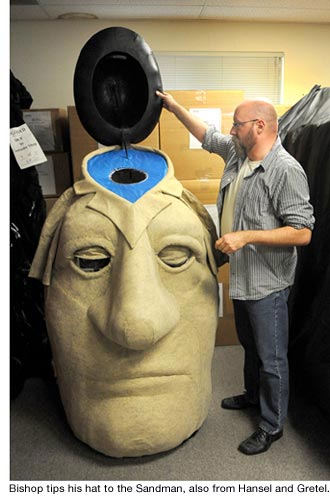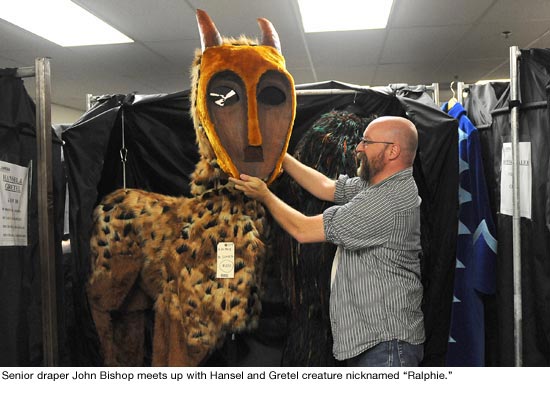Dressed to thrill as LA Opera turns 25
October 26, 2011
A big birthday calls for some standout clothes. And let’s face it—when the honoree is an international superstar, the more over-the-top, the better.
As L.A. Opera celebrates its 25th year this month, its costume workshop in Little Tokyo is stitching away at full tilt. Creating exquisite outfits for the latest production, Gounod’s “Romeo et Juliette,” is just part of what’s going on.
Beyond the fittings and the finery, the workshop is shining brightly in its own supporting role, serving in effect as a gigantic walk-in closet for all the star-crossed lovers, murderous villains and phantasmagorical creatures who’ve thrilled L.A. opera audiences for the past quarter century.
Looking for enough boots to outfit a regiment? You’ve come to the right place.
A dragon gown with 25-foot train? They’ve got one.
Or perhaps a dressmaker’s mannequin shaped exactly like Plácido Domingo’s torso? Of course, along with the doublet and robe he wore when he starred in Verdi’s “Otello” in 1986.
That performance marked the beginning of opera as we know it in L.A.—a 25-year run that’s being celebrated at the company’s first ever open house at the Dorothy Chandler Pavilion in downtown Los Angeles on Saturday, November 5.
It’s all free—including performances and “Meet the Maestros” sessions featuring Domingo, the company’s general director, and its music director, James Conlon. (Advance reservations are recommended for those and some of the other parts of the day-long program, and a $1 handling fee applies; more information is here.)
In addition to performances of the children’s opera “The Prospector,” the open house also will feature a small but impressive sampling of the company’s vast costume collection, along with wigs, props and scenery.
Items selected to show off the costume workshop’s versatility and artistry include the Infanta’s costume from Zemlinsky’s “The Dwarf,” part of the company’s “Recovered Voices” series dedicated to rediscovering operas lost or neglected because of the Holocaust, and the costume worn by the title character in the Julie Taymor-directed “Grendel,” along with a spectacular dragon gown from the same work.
Special demonstrations at 10:30 a.m. and 3:30 p.m. will reveal some of the inside secrets of the craft.
For those who work there, the Alameda Street costume workshop has offered a front-row seat at L.A. Opera’s evolution.
 “It has changed dramatically,” said Greg White, the costume department manager who’s worked there 22 years. “It’s been fascinating watching the company grow over the years.”
“It has changed dramatically,” said Greg White, the costume department manager who’s worked there 22 years. “It’s been fascinating watching the company grow over the years.”
(This history on the company’s website charts some of the memorable moments, including the role of founding general director Peter Hemmings, the triumphs of the Domingo era and Conlon’s arrival in 2006.)
On a recent afternoon, White and senior draper John Bishop were able to point out some of the wearable souvenirs of L.A.’s operatic history as they walked through the two-story workshop/warehouse.
A stroll to what’s known in-house as the “diva rack” turns up Domingo’s duds from “Otello,” “Carmen” and “Samson & Delilah,” as well as costumes worn by Kiri Te Kanawa in “Vanessa.”
Not too far away is Frederica von Stade’s gown from “Grand Duchess.”
Costumes from last year’s ambitious staging of the operas in Wagner’s Ring Cycle are zipped into rows of oversized and carefully labeled fabric cases on the second floor. (But three costumes for Loge—the trickster fire god from “Das Rheingold” and “Siegfried”—remain in full view at the end of the hall.)
Sometimes the job requires finding a delicate balance between the costume designer’s vision and the performers’ preferences and physiques.
“On projects like The Ring, everybody has their opinion. Thankfully, with The Ring, most of the singers realized that vanity had no place in it,” Bishop said. “Most of the singers learned to roll with it.”
Some of the costumes have become workshop favorites, like the centaur-like creature nicknamed “Ralphie,” who appeared in “Hansel and Gretel.”
Others are remembered more as technical challenges that had to be wrestled into submission—like those colorful but architecturally demanding velvet coats from “Der Rosenkavalier.”
No matter how demanding the workday—including a recent marathon fitting session involving hundreds of costumes that had to be “planned like a military exercise”—there’s a pride in playing a pivotal role in every production.
“We’re certainly part of the storytelling,” Bishop said. “You will find everybody here is in love with what they do.”
Earlier this month, one of the workshop’s periodic public costume sales helped clear out some of the excess inventory. “All of it helps because it fills up so quickly back here,” White said. “We tend to be rather packrat-ish.”
While customers at the sale may have picked up some spectacular trick-or-treating ensembles—including someone who paid $2,500 for a get-up from “The Fly”—Halloween remains a little ho-hum for those who have turned costuming into high art.
“It’s a busman’s holiday in my book,” Bishop said.
Posted 10/26/11
Photos by Scott Harms/Los Angeles County
Posted 10/26/11

























 405 bridge work causes a stink
405 bridge work causes a stink